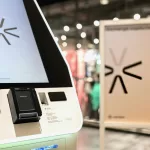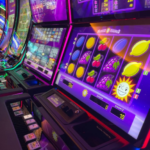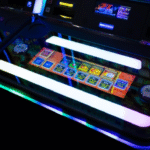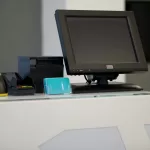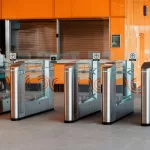A Shift in Gaming Interface Design
Gaming cabinets have long relied on mechanical button arrays. However, the landscape is changing. Interactive button deck monitors powered by PCAP (Projected Capacitive) touch technology are leading this transformation. These innovations not only enhance aesthetics but also streamline user interaction. At rCloud, we analyze how this interface evolution is redefining the future of gaming experiences.
From Mechanical to Digital: The Industry’s Turning Point
Traditional gaming cabinets featured tactile, click-based buttons. They offered basic functionality but lacked flexibility and design fluidity. With the emergence of touch interfaces, especially PCAP-based panels, manufacturers began shifting toward sleeker, multifunctional displays.
PCAP touch decks allow gamers to interact with digital environments intuitively. Unlike mechanical buttons, which require fixed cutouts and rigid layouts, interactive displays enable dynamic content, real-time updates, and seamless transitions.![]()
Understanding PCAP Technology
PCAP (Projected Capacitive) technology senses touch using conductive layers and an electrostatic field. It supports multi-touch functionality, high precision, and is resistant to dust and liquids. These characteristics make it ideal for gaming environments, where responsiveness and durability are essential.
The core components include:
Transparent conductive sensors
Controller ICs
High-transmittance cover glass
These layers work together to register even the slightest touch, enhancing user feedback and gameplay control.
Design Freedom and Customization
One major advantage of using a PCAP touch button deck is design flexibility. Traditional button decks are limited by mechanical constraints. Each button must be physically placed and labeled. In contrast, PCAP displays offer:
Dynamic content zones
Multi-language support
Game-specific layout reconfigurations
This opens up limitless possibilities for theming, seasonal updates, or promotional displays. Developers can customize the interface without hardware changes, saving both time and cost.
Enhanced Durability and Maintenance Benefits
Mechanical buttons wear out. They are subject to repeated force and environmental stress. PCAP decks, with solid-state surfaces, dramatically reduce mechanical failure.
Touch interfaces eliminate the need for moving parts, thus lowering maintenance requirements. Additionally, cleaning becomes easier with flat surfaces, which is especially valuable in high-traffic gaming environments.
Real-Time Interactivity in Gaming Applications
Today’s gaming content demands dynamic interaction. Touch-enabled button decks allow games to evolve beyond fixed controls. Buttons can morph into sliders, toggle switches, or animated triggers, depending on game needs.
This versatility enables:
Real-time feedback and animations
Interactive lighting effects
Input responsiveness matched to gameplay speed
Such features make the experience more immersive, especially for next-gen slot machines and digital table games.
Integration with Backend Systems
Interactive decks are more than just interfaces. They connect with backend systems to manage player data, loyalty programs, and performance analytics.
Via secure APIs, game developers can:
Update layouts remotely
Integrate with CRM systems
Push targeted promotions to specific machines
This level of control was never feasible with mechanical buttons. Now, touch-enabled decks serve as intelligent terminals within the cabinet ecosystem.
Future-Proofing with Modular Displays
Interactive button deck monitors offer scalability. As games evolve, cabinets equipped with PCAP decks don’t need hardware replacements. Software updates can redesign entire control interfaces instantly.
This modularity also allows:
Quick game swaps
Cross-platform compatibility
Device-agnostic controller layouts
Cabinet manufacturers benefit from longer product lifecycles and lower retooling costs, giving them a competitive edge.
Real-World Case: rCloud in Touch Deck Innovation
We supply integrated button deck solutions that combine PCAP touch screens, industrial-grade enclosures, and versatile controller interfaces.
Our clients report:
45% reduction in maintenance calls
60% faster customization turnaround
Improved user engagement metrics
rCloud’s engineering approach prioritizes signal clarity, anti-ghosting, and haptic compatibility. We also support both flat and curved form factors to meet diverse cabinet designs.
Challenges and Engineering Considerations
Despite clear benefits, adopting PCAP decks poses challenges:
EMI susceptibility in noisy gaming environments
Need for robust firmware calibration
Surface hardness vs. touch sensitivity balance
rCloud mitigates these with multi-layer shielding, firmware optimization, and rigorous QA testing. Each unit passes electromagnetic compatibility (EMC) and pressure sensitivity benchmarks before deployment.
Regulatory Compliance and Safety
All rCloud touch decks adhere to:
CE and FCC guidelines
RoHS material standards
UL safety certifications
Moreover, our decks support ADA-friendly modes and customizable accessibility overlays.
Outlook: A New Standard for Gaming Cabinets
The interactive button deck monitor is no longer a luxury. It is fast becoming the default. As digital interfaces mature and user expectations grow, cabinet makers must adopt smarter, more adaptable control systems.
rCloud remains committed to innovation in this field. Through R&D, OEM partnerships, and agile engineering, we bring future-ready touch button decks to life.
Conclusion
Interactive button deck monitors represent a paradigm shift in gaming cabinet design. By replacing mechanical buttons with dynamic PCAP touch decks, the industry is embracing customization, reliability, and immersive gameplay.
With rCloud’s tailored solutions, manufacturers can confidently transition into this new era. The future of gaming interaction is touch-based, software-defined, and endlessly adaptable.
Elevate your cabinet experience. Choose rCloud.

